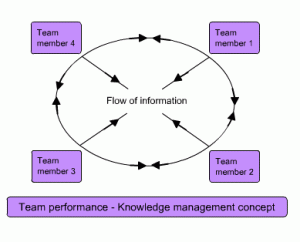The term Knowledge Management was coined fairly recent. Though the concept has always been around, it is only in the information technology age that organisations have started looking more closely at this process and are designing formal systems to facilitate organisation-wide information sharing. You will find several definitions, but the definition found in the glossary of terms at ahima.org explains this concept best. Knowledge management is – ‘Capturing, organizing, and storing knowledge and experiences of individual workers and groups within an organization and making this information available to others in the organization.’
Information sharing plays a big role in team performance. Teams are increasingly being used because their combined effort is proven to deliver much more than what team members can individually accomplish. Teams are meant to tap into their individual knowledge and then use the collective wisdom within the team to devise smart strategies and generate creative ideas. A team’s performance is therefore vastly dependent is how far the collaborative aspect of teamwork is truly put into action. And effective knowledge management within the team is a major facet of collaborative work. The concept of knowledge management in fostering high team performance is based on the premise that it is essential to tap into the collective knowledge, experience, expertise and insights of every team member for a team to deliver results.
The team’s interactions have to facilitate movement of knowledge and information through the entire team. It is a concept where peers exchange views, exchange insights, exchange experiences and then use this knowledge to debate and discuss problems. Their meetings, discussions and other interactions have to operate like a ‘round table conference’ as shown in the figure below.

The flow of information has to encompass every member on the team. Even when individuals tap into outside resources such as experts, consultants or inter-office resources to help on a task, all the information that’s gathered has to be fed back to each and every member on the team. Some of the information can be shared during group meetings. Certain types of information are better shared one-on-one. At times written documentation is called for and at times, it may be necessary to feed information into a common database accessible to all team members ( for data such as sales tracking, statistics or economic indicators),
Every member on the team is an intellectual asset that has to be tapped by the rest of the team if they want to deliver results. Knowledge gaps that may exist among individual team members can often be filled by others within the team itself since the team-mix is often selected keeping in mind the complementary skills necessary to balance the expertise within the team.
So, where will the knowledge management model find application in generating high team performance? Good knowledge management practices are essential in all teams but it is especially necessary in teams where the team’s output is of a conceptual nature or strategic nature and requires drawing up proposals or recommendations based on the broad range of experience and skills in the team. Experience across business categories; cross functional expertise; or even cross-cultural exposure. Typically, this could be a think-tank, expert group, project task force, overseeing committee, a team in a consultancy firm, a team handling market research, a strategy planning cell, and so on.
Smart knowledge management ensures that the raison d’être for the team’s existence is truly effective. We know that teams are created to combine their individual capabilities to generate results that are far superior to what individuals can achieve if they operate separately. If that’s the basic concept of a team, then the knowledge management method is the most powerful way to facilitate a high team performance. When there is regular information exchange among the team members, it becomes a valuable backdrop for all the decisions taken, and for all the actions pursued by the team. The end result is a far better team performance and this in turn improves the performance of the organisation as a whole.
 Team Building Portal
Team Building Portal